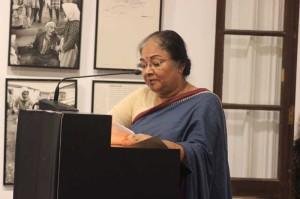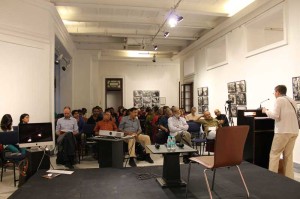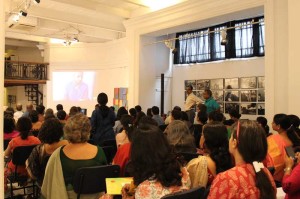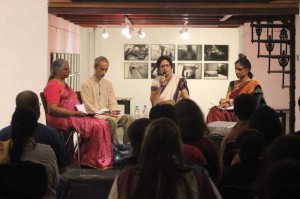Day 2
At the end of the first day of the conference, Ms Malhotra was convinced that we had packed too much material into the first day and that the participants would perhaps take the day off. She was, however, ecstatic to be corrected as everyone came back for another day of intense disscussions.
Keynote:
The second day of the conference began with a keynote delivered by Mrs Devi Kar that succinctly summed up what was to follow. Happy that she had the opportunity to present the school’s perspective to the historian’s in the room, Mrs Kar went on to elaborate on how the teachers of Modern High School for Girls’ approach history. She said it is essential for facilitators to have a sense of self-reflection to allow children to develop what she called historical thinking. For students who find history burdensome and boring, who agree with Tolstoy in that ‘Happy people have no history’, the subject needs to be able to incite critical thinking. That can only be done when the child has the opportunity to compare and weigh evidence, judge facts honestly, in Sam Wineburg’s terms, reading history like a historian. History, according to him, is a process of enquiry. Referring to Professor Sethi’s workshop of the previous day she stressed on how important it is to follow his model in the classroom to ensure that history was no longer seen as a subject to be swallowed and regurgitated for the examinations. Multivocality emerged as a strand of thought that had flowed in from the day before as she stressed its importance. About peace education, she opined that we should not shirk around violent pasts and manipulate our history but use the memory of the trauma as a vaccine against more such incidents. Textbooks need to embrace heteroglossia to expose students to multiple histories, thus curbing a vicious othering. Peace will thus emerge through dialogue and debate. As Einstein said, peace cannot be kept by force.
A very enthusiastic audience piped in here, pointing out the prevalent gap between teaching and learning and the problem created by the examination system. A member of the audience chipped in with how they had averted denying the examination system but had instead come up with a parallel mode of teaching history so that there would be something for the children to take away from class. Modern High School encouraged projects or presentations to encourage students to use the constructionist approach. Ms Sarkar from Assam Valley mentioned how they avoided textbooks as far as possible to keep students interested. Professor Sethi joined the conversation at this point, in defence of the textbook, wondering if it is not possible to come up with an approach that incorporates the textbook while interesting the student.
Teaching Contentious History: Case Studies from Around the World
The next person to take the podium promptly at 10 a.m. was Dr Barbara Christophe. Building on the threads of multivocality that had developed in the conference Dr Christophe presented, in minute detail, three common history textbooks that have been developed in the world.
The first book she looked at was the Franco German common history textbook which was the first of its kind in the world. Between the years 1870 and 1935 the two countries fought three wars against each other. There were five stages of development of this textbook – the first stage was in 1931 when discussions were conducted about a culturally focused history book, issues registered and recommendations published in the public newspapers. However, the efforts failed because of Hitler. Post World War II between the years of 1948 and 1950 discussion was resumed and the two countries came to an agreement on controversial issues in 1951. The book was to be built around a compromise narrative that told the tale of innocent populations that were manipulated by the political elite, emphasising topics that encouraged reconciliation. A series of conferences followed and in 1980 history and geography teachers assembled at the Georg Eckhert Institute to develop a narrative of their mutual perception of Europe resulting in teaching materials. It was much later, in 2003, that the idea of a common history textbook was brought up by the Franco-German Youth Parliament. In 2006 the first volume of the common history textbook was published, addressing the common history post 1945. The most difficult part of this book concerned the curriculum, about which the German’s were vague while the French were very particular. The book was a product of the joint effort of the state and scholars and created to compete with other books on the market. The book itself was formed of a common narrative of entangled history combined with classical German and French topics and both the country’s respective opinions chalked out on the pages with emphasis being given to common processes. A major shift that could be observed was the shift in perspective, celebrating cultures that emphasised victimhood instead of heroic cultures, a stand that was approved by the state. The contended issues in the project were the amount of space to be given to popular culture, their relationship with USA, which was seen as a protective force by the Germans while the French regarded the country as an imperialist force along with the issue of communism.
The second project she discussed was the German-Polish textbook which was created amidst a very tense political scenario with the history of war between the nations and the imprecise Treaty of Warsaw. There is also an unequal relationship between the two the countries reflecting in the 2 million Poles who learn German as opposed to the 7000 Germans pursuing the Polish language. The efforts started in 1956 and by 1975 the UNESCO Polish German committee had presented the first recommendations. The conservatives rose up in protest that the historical truth had been given up. The strong negative feedback incited more interest in Pole-German relations which developed into a professional committee and by 1976 the idea for the common history books emerged. These books were to contain eye witness stories, a history of the Jews in Poland, gender history and social history. Work on the book started in 2008 with texts being exchanged between the two countries and conferences organised which brought to light that the difference of opinion about the middle ages were the most difficult to overcome. The contended issues include the Western Border, the expulsion of the Germans from Poland which was expressed as a transfer of population, the success of Germany in integrating the population and debates surrounding the diffusion of culture. The book is slated to be published in 2015.
The third book discussed was the Israel-Palestine common history book, which emerged amidst asymmetrical power balance between the two countries. The process for the book which began in 2002 stemmed from the Peace Research Institute which thought of building the pressure bottom up. The countries started with an exercise on trust building following which the book adopted a dual narrative approach which increased awareness. There were, however, many blind spots which reflect opposing thoughts and tilted emphasis or even telling silences. The resultant book was banned by both the states in 2010.
In the conclusion Dr Christophe noted how important state support is in such an endeavour because otherwise the end product of so much effort will get banned by the authorities, as seen in the case of the common textbook for Israel and Palestine. She also mentioned how the process, which entails interaction between each other and changes subtly the mind sets of those involved, itself is more important than the end result.
The talk, with its indirect relevance to classroom teaching, was felt to be ‘erudite and informative’ and one ‘providing food for thought’ by Ms Gowri Mirlay Achanta, a teacher of history who was part of the audience. She began the subsequent discussion by sharing how she acquired a Pakistani textbook and explored their version of history with her class. But what about when the teachers do not have access to these textbooks? She also shared how a Punjabi student’s grandfather who had gone through Pakistan had written a memoir for his family which included pictures of his wedding card with intrinsic calligraphy in Urdu, a combination of script and ethnicity that I for one had never fathomed inspite of the knowledge that Punjab is a province of Pakistan.
There rose the question of the possibility of a common textbook for the subcontinent when professor Sethi explained how the NCERT had attempted to compile an Indo-Pak-Bangladesh supplementary textbook for Class X students. That attempt had been hampered by logistical issues. There was also the task of selecting content which would not end up being a tortuous read for the student. Professor Jha interrupted here, stressing that one should insist that history is interesting and not oversimplify the subject. His solution for resolving complicated issues is by providing sources. The conversation at this point veered back to Dr Christophe’s paper when Ms Tina Servaia asked her if she thought the common history book would have been possible without a decrease in German nationalism. Dr Christophe explained that Germany was ashamed about what was happening and this was an effort on its part to resolve past issues.
Deeptha Vivekanand then raised a very important issue –-the south of India and Sri Lanka had so far been ignored in the conversation, the absence of which she strongly questioned. She also commented on how the discussion had so far been very partition centric, thus alienating the south of the state. Professor Sethi accepted that there is an imbalance in the history dealt with in our classrooms but he assured that there has been progress. The partition, he insisted, impacted the south as well, an effect that is to be found in the Sindhi colonies that grew up in Bangalore.
A much needed coffee break followed the intense morning.
As everyone reassembled after the coffee break, we connected to Qasim Aslam from Lahore through Skype hoping that the network would hold up this time around. It held steady and everyone dived right into the conversation as Mr Aslam took us through The History Project Society and its objectives.
History, reiterated Mr Aslam, was used by the state as a form of nation building. The most dependable way of arriving at nation building is to use the subject to project the image of collective suffering of the state at the hands of a common enemy, inculcating thus the victim syndrome in the masses. The concept of us is divorced from the events of the world leading to intolerance in children and a refusal to consider alternative opinions. This is the result of the absence of a contrarian opinion in the textbooks these children have access to. The History Project Society looks at history as a study of change in our time considering the five Ws –what, when, why, who and which. For instance, the question “Are all women equal in India” has to be refined to some around the lines of “Did royal women in 16th century Mughal India have the same access to economic resources as men? To arrive at a question that is approachable with much lesser scope for generalisation. The History Project has put together an alternative textbook by juxtaposing narratives from Indian textbooks with Pakistani ones which was published in May,2013. They have also developed an activity based curriculum to ensure that students are more involved in the subject, and an impact tracker with which to record and observe development which they use in their partner schools which now number over 50.
When asked whether art or music can be employed to highlight the similarities in people, Mr Aslam pointed out that the crux of the problem is that we are highlighting more negatives than positives and that consciously highlighting similarities would aid peace education in the future. He mentioned a museum being set up in Texas by an Indian gentleman focusing on highlighting similarities. He was further asked how one can teach history without grounding the truth somewhere else. Mr Aslam explained that one of their methods is to mime out a fight between two people at the end of which one person barges out of the room. The children are then asked to figure out what happened, resulting in a number of different perspectives. Once even one child realises the sheer number of perspectives concerning one incident, the rest follow. Answering a member of the audience who questioned the use of master narratives and the role of a teacher in such a setup, Mr Aslam said that the narratives used in their books were taken from textbooks of the boards in Punjab and Maharashtra which have the highest following. The same technique was employed in garnering the Pakistani narratives. The idea of the book, he said, was only to aid the teacher to use the material available. Addressing a concern that the material was too partition centric, Mr Aslam said that this was just the initial step and that other concerns would gradually be addressed. The last question of the session was the most interesting one and got the most interesting response – a teacher of the audience asked how a teacher, when asked a well refined question in the classroom, should respond. He asked in return what education means to us. To him education is empowering the child to answer the question. The onus is on the child to go out and find the answer to the question. The moment the child is exposed to multiple narratives he or she develops the ability to process their own narrative.
Teaching Divided Histories
As Mr Aslam signed off, Meena Megha Malhotra took the stage to introduce Teaching Divided Histories, a project that originated in Nerve Centre, an organization based in Northern Ireland funded by the European Regional Development Fund under the Peace III programme. The project focusses on the use of digital media to teach history to today’s tech friendly students in a language that they are most comfortable with. PeaceWorks, appointed the international partner for the project has developed a supplementary curriculum module relevant to classrooms in the Indian context. Focusing on the Hindu Muslim divide in the subcontinent, the Indian chapter of TDH is a resource with assignment ideas using digital media. Supplementary material and teacher training is also provided. The module has been implemented in eight schools in India and one in Pakistan. Of the eight Indian schools that have given this project a go, teachers from Modern High School for Girls and Calcutta International School stepped up to share their experience.
Ms Sunita Biswas from Modern High School explained that even though this module was meant for Class 9 students, they worked with Class 7 students to marvellous results. Taking up Civil Disobedience under the Human Rights section, they incorporated the module not in an extra class, but in the time allotted for value education. The students were also told to go back and find someone who had witnessed Civil Disobedience and record their interviews as holiday homework. Every student found one such person among the people they knew, usually family members. They conducted interviews over phone and on video, recording the oral narratives of the interviewees. In the course of the project the girls realised that the interviewees told them much more off the camera than when they were being recorded and that the anger that ran across all the interviews was directed not at other communities but the authorities. The short story Pali by Bhisham Sahani was incorporated in the English literature class. Graphic novels and flipbooks were created by the children for this part of the module. For the Fact and Opinion section of the module the students dealt with religion and politics in their history classes for three weeks, an effort which culminated in a blog created on Nicenet, a non-profit internet platform. They also had a talk by Mrs Uma Ahmed who narrated her personal experiences of the partition.
Tina Servaia then came forward to present Calcutta International School’s experience surrounding the module which they implemented with class 8 children. She mentioned how there is very little space for Indian history in their school which is mostly Euro-centric even though it is gradually being changed into a world-centric curriculum. The multi-ethnicity of the children made it difficult for them to grasp the importance of the Partiton in the sub-continent. Instead, they were told to explore their own local histories and local contentions creating an interesting dimension of constant comparison. A Korean child came up with an idea that perhaps the lingering problem between India and Pakistan was due to nomenclature. In Korea, the divided countries of the north and south still carry the name Korea even as India and Pakistan shared no such common feature in their respective names. The parent of the children were extremely involved in the project making it an inclusive collective effort. Each student made an individual history using the constructivist approach. Ms Servaia reiterated the importance of introducing such topics in a classroom as otherwise it the students get exposed only to one version of what happened, without any scope to explore the subject any further. When they turned in the podcasts and video projects that they made it was apparent that the prejudices that had appeared to melt away inside the classroom resurfaced. The most interesting part was that the prejudiced children had not in any way been affected by the partition and so there was no apparent source of their negativity. Ms Servaia opined that this initiative has to begin right from primary school as by secondary school the biases are already internalised by the children. Her school, she said, exemplified how the Teaching Divided Histories need not be confined to the partition but can be utilised in other contexts as well.
The following discussion brought up the troubling subject of parent vs teacher, where the teacher’s efforts in the classroom are at a severe disadvantage because the child unlearns the classroom education at the hands of their parent. Inspite of it all, the teacher, opined Professor Sethi, has to persist. Ms Ghosh then mentioned that history has to also include the contexts of events, the social processes which build the subject.
The Alternative Approach: The Krishnamurti Foundations Approach
The morning presentations saw ample evidence of how the innovative techniques of teaching history were being used in the classroom. Reassembling post lunch at 2pm, the audience got a glimpse of how the Krishnamurti Foundation Schools incorporate the philosophy of their founder, the philosopher J.Krishnamurti. The session, moderated by Mrs Amita Prasad, saw G.Devika and Akhila Seshadri from The School and Krishna Menon from Rishi Valley School.
G.Devika, who has been associated with the Krishnamurti schools for over 13 years now, stated that the philosophy adopted by the Krishnamurti schools exhorts individuals to know their history in order to go beyond it. A certain way of looking at the past is a privilege, she said, even as history is being reduced to a list of names, dates and events by changing texts. History is our understanding of the past, the truth of which we never really know. For Krishnamurti, history was essentially the biography of mankind. He viewed history not as a settled fact but insisted on freedom and enquiry, fostering a global outlook in the child. Incorporating this philosophy into their lessons, the Krishnamurti schools follow books written only by professional historians while the guest lectures, field trips, multiple perspectives and the importance given to sources help the children distinguish between claim and fact. The students are encouraged to look into the context and recognise the problems inherent in the system. The student’s location in their own social construct is stressed upon. At the end of her presentation she questioned whether there can be a best way of teaching history.
Krishna Menon read out a paper written by Dr Radhika Herzberger, Director of Rishi Valley School in which Mr. Menon spoke about the need for unity of mankind, concern for the species we share the earth with and for globalisation. A rationalist view of the past, based on evidence and incorporating humanist thought is required. By providing a socioeconomic perspective of the world to students they help to incorporate ethical thinking. They begin with a broad overview of a topic before starting a debate in the classroom.
Professor Sethi pitched in here saying that a comprehensive account of everything becomes tedious for the child and so they have to pick and choose the topics discussed which they then provide an in depth analysis for. There is an attempt to cover most of India but the material covered depends on the experts available during the making of the book.
Ms Servaia then asked if it is possible to build a curriculum around a skills based approach retaining narrative cogency. Professor Sethi replied that the temporal and spatial context of an event is borne in mind when it is mentioned in the book, but too much detail makes it burdensome on the student. It is a fine balance to choose those events which find place in a history book and also teach the student the historian’s craft.
Ms Prasad commented on the importance of taking history out of the classroom, the very essence of Ms Seshadri’s presentation. Ms Seshadri referred to Dr Christophe’s idea of the process being more important than the end result, asking whether it was possible to put the student at the centre instead of content. She shared a historical trip that The School takes its Class 8 children on, to teach them to record, learn, assess and develop a well assessed conclusion of what they are seeing. They are taken to historical landmarks such as Hampi and Thanjavur after being exposed to information surrounding these places through various mediums of art, thus incorporating a multidisciplinary perspective of looking at history.
Film in History
Later that afternoon two very innovative films, meant for students from classes 7 to 10 were screened by the International Public Television (INPUT). The first film was a Japanese one and had as its hero the samurai warrior Minamoto no Yoshitsune and told the story of the Battles of Ichinotani, Yashima and Dannoura which were fought between the Heishi and the Genji, alongside the changing relationship between him and his brother. Inspired by the world of gaming, the film is pulsating with colour, song, kabuki and flashes of anime. The dates shown on the film are incorporated within rhymes which allow for easy recall.
The German film screened next was in the format of a television news channel, reporting Napoleon’s war with the Russians, created using archival material alongside carefully created shots. Shifting in between shots of battle, the newsroom and frantic reporters, the film reiterated important points as breaking news. However, it did appear a tad too long and repetitive for a newsroom presentation.
Both the films insisted on showing past events as though they were unfolding in the present and were catchy enough to have the attention of the entire audience through almost the entire length of the screening.
Performance
The evening ended with Dear Earth… Hope you are keeping well! , a performance by Chaepani which attempted to be a dialogue between Rabindranath Tagore’s short story Kabuliwallah, Zaheda Hina’s fictitious letter Kumkum Theek Thak Hain and poems written by prisoners of Guatanamo Bay as modes of resistance. Travellelling between the borders of narrow nationalisms in South Asia, cultural xenophobia and religious fundamentalism, the project appeared to have blurred their intended message.
At the end of the second day of the conference, ‘We got to understand where the fault-lines are, which I think is always the best part of conferences,’ opined Ms Ghosh.




